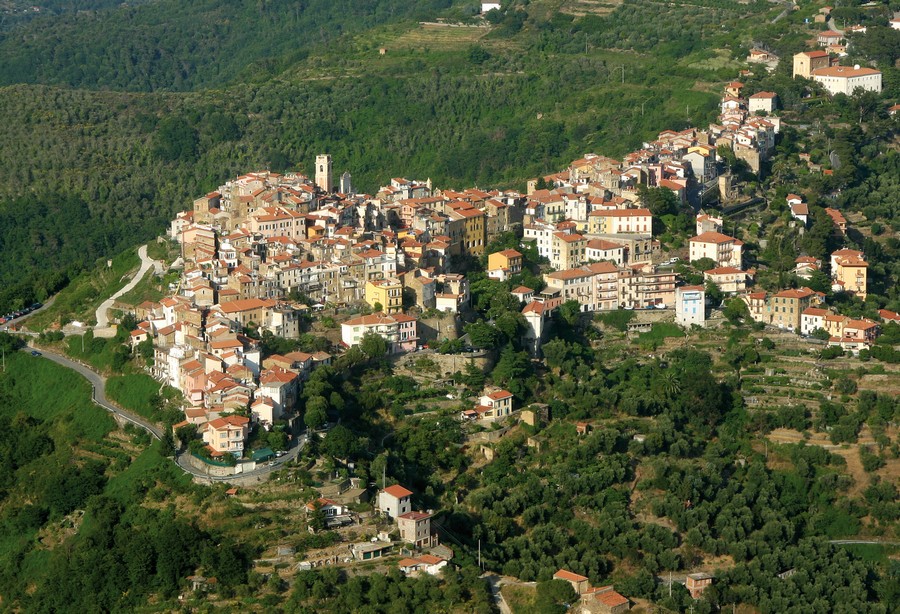Altitude: 572 m a.s.l.
Area: 21 sq km
Distance from Imperia: km 53
Inhabitants:
- in 1881 2017
- in 2017 881
Patron Saint Day: December 6th - San Nicolò
Information: Municipality tel. 0184 672001
The name of Perinaldo derives from that of the founder, Count Rinaldo ("Podium Rinaldi") of Ventimiglia who created it by merging the two villages of Vincedelo and Incanedelo.
The village was sold in 1288 to Oberto Doria di Dolceacqua and was ceded to Carlo III of Savoy in 1524.
Some great personalities of the seventeenth century scientific world were born in Perinaldo.
Among others we can mention Giò Domenico Cassini, eclectic scientist who was called by Louis XIV to design and build the astronomical observatory of Paris. He was also the one who drew the map of France.
Worthy of mention are also other members of the Maraldi family who he called from Paris to collaborate in his work, who were all Academicians of France.
Visit of the town
Go up by car keeping the left at the crossroads that leads to the Town Hall on the right and then park near the fountain with a 1895 stone basin.
Taking the street on the left, pass the monument to the Fallen, noticing at number 58 the richly carved door, deteriorated however in the lower part; further ahead at number 20 opens the marble portal with rosettes at the jambs of the birthplace of Cassini and Maraldi, enriched by the angel's head carved in the marble of the next portal.
Continuing, you can notice at number 12 the rustic monolith of 1571, carved with a rough Trigram on the right and a cross on the left between the letters F B A B and then the small aedicule above number 5 with a marble statuette of the Virgin and the Child, the latter however mutilated of the face.
After the stone benches, the road opens into a widening where, under the vault on the right, there is a fountain with a stone basin that feeds the drinking trough across the street.
A little further on, above number 24, opens the black stone aedicule carved with floral motifs with a Trigram in the center and the inscription "OGNU' - CHE PASERÀ P. QUETTA VIA - DOVERÀ SALUTAR GIESU-MARIA"; alongside is embedded the wrought iron arm that held the lamp.
At the beginning of the next widening you’ll find a plaque with a griffin in an oval of raised ashlars and rough geometric decorations affixed at number 3; here at number 1 there is the rectory, with a simple black stone portal with a roof.
You have thus reached the churchyard of the church of San Nicolò di Bari, anticipated by a large staircase with the Municipal Loggia on the right and the squat bell tower with a slit under the bell cell on the left.
The church, of medieval origin, was rebuilt in Baroque style in the seventeenth century; of the original structure has remained the colombina stone architrave of the right door, of 1495, which carries an Agnus carved in the center flanked by shields with an eagle, the coat of arms of the Dorias di Dolceacqua, and floral decorations at the ends.
The larger analogous lintel of the central door has ended up vertically embedded in the small wall on the right which supports the flight of steps; mutilated on the right side, it preserves the Agnus in the center and the Doria’s eagle on the left, both with only the muzzle abraded in partial execution of the Napoleonic edicts.
The interior of the church has three naves, divided by stone columns with a high base and Doric capitals linked by pointed arches.
In the last altar on the left there is a particularly suggestive medieval Crucifix, and in the altar on the opposite side there is the seventeenth-century canvas of the "Holy Suffrage" donated by the astronomer Cassini; the apse is singularly bare.
Leaving the church, go left to see the loggia with stone seats, a fountain and a plaque of 1861, beyond which the widening of the Belvedere Chianea opens over the valley.
Back to the square, take the stairway that climbs alongside the church, thus leading to the tiny rustic Piazza Castello; of the original fortress only a few traces remain, visible on the left passing under the arch next to number 11: an ogival stone arch and the medieval window that follows it.
From Piazza Castello continue under the vault in front of the fountain, leaving the walls, along which you can continue to the left until you’ll return to the village through the gate next to the polygonal staircase.
After passing the stone portal with a round arch of the building housing the local Philharmonic on the right, you’ll find a little further ahead at number 2 a carved door faced by the smoked window of a blacksmith's forge.
Passing after number 9 the very narrow steep alley on the right, continue to the church square from which you can take, on the right of the loggia, Via San Benedetto which leads to the small open space with stone seats where stands the Baroque oratory of the same name, with a triangular bell tower and, affixed on the façade, an oval plaque with a relief of the Virgin and Child.
Continue under the first vault and then under the next one on the right, then taking the left to find yourself on the central street.
From there go right venturing, at the beginning of the ramp that leads to the church square, under the vaults of Via Cassini, the heart of the medieval citadel; going back to the square you can go down briefly to the left on Via Gioberti to see the portal at number 11 curiously decorated by a plaque with a stone ball.
The Astronomical Observatory (tel. 0184-672463), whose telescopes are available to the public, is located in the Town Hall.


